7 Under the Radar Watches from Omega, Zenith, IWC, Jaeger-LeCoultre, Blancpain, Girard-Perregaux and Cartier
by Raman Kalra
Raman Kalra is the founder of The Watch Muse blog and has kindly agreed to share some of his articles with us here on Quill & Pad.
___________________________
I have no doubt that nearly everyone reading this knows the iconic watches that big brands produce. Even people outside watch circles have a fair idea of at least a few of them. I am talking about the likes of the Rolex Submariner, Omega Speedmaster, and Cartier Tank to name just a few.
As these models gain so much attention, it is sometimes forgotten that these brands make other collections, some of which are extremely compelling. It is time we looked at what some of those might be. Not everyone wants to own the icon. Some want to stand out for their individuality or even go under the radar. These other models offer a different aesthetic and heritage yet maintain the quality and brand allure found in the icons. Below are collections from some of the largest watch brands that I don’t feel get as much attention as they deserve.
I’ve left a few off such as Audemars Piguet because all their watches are receiving attention – at least in my view. I know that there are even more examples out there and I might follow up with another post in the future building on the below. In the meantime, I would love to hear your thoughts on what should be included next time.
Omega Globemaster
Omega is synonymous with the Speedmaster and Seamaster, and for good reason. In recent years, even those models within these two ranges that were not historically popular are gaining more attention – just look at the Aqua Terra or Dark Side of the Moon Speedmasters. However, the Constellation range is rarely discussed, and within that sits the underrated Globemaster. The Globemaster is a rather unique offering from Omega. It is a time-only option with different strap options, like many other models, but it sits between a sports watch and a dress watch.
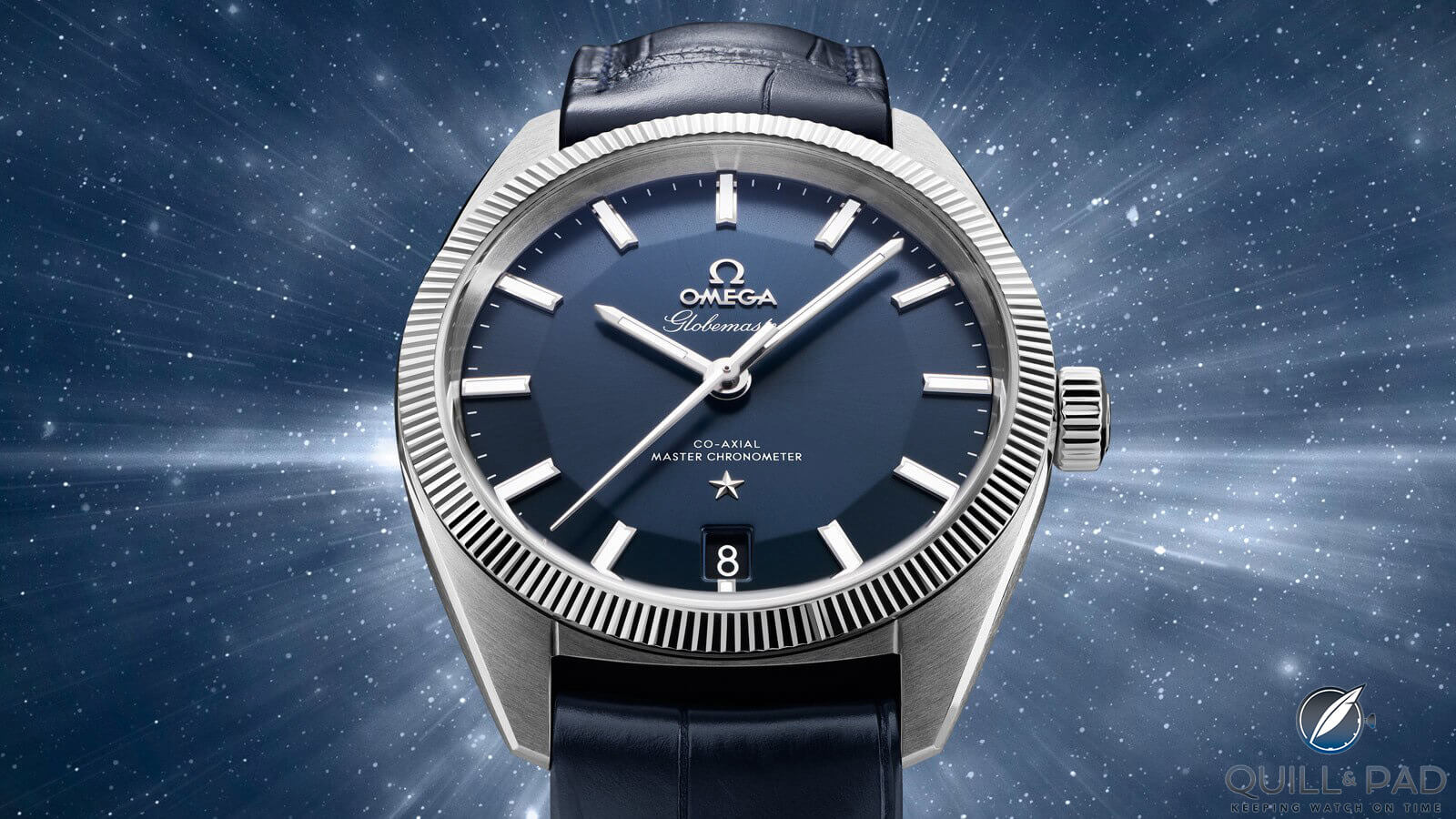
Omega Constellation Globemaster 39mm
Launched in 2015, Omega has combined stylistic cues from its past with modern technology, sizing, and versatility. It comes in a very wearable 39mm case diameter, with 47mm lug-to-lug, and various case materials and strap options. Despite this Globemaster being a modern iteration, it has several links to the original Constellation range dating back to 1952.
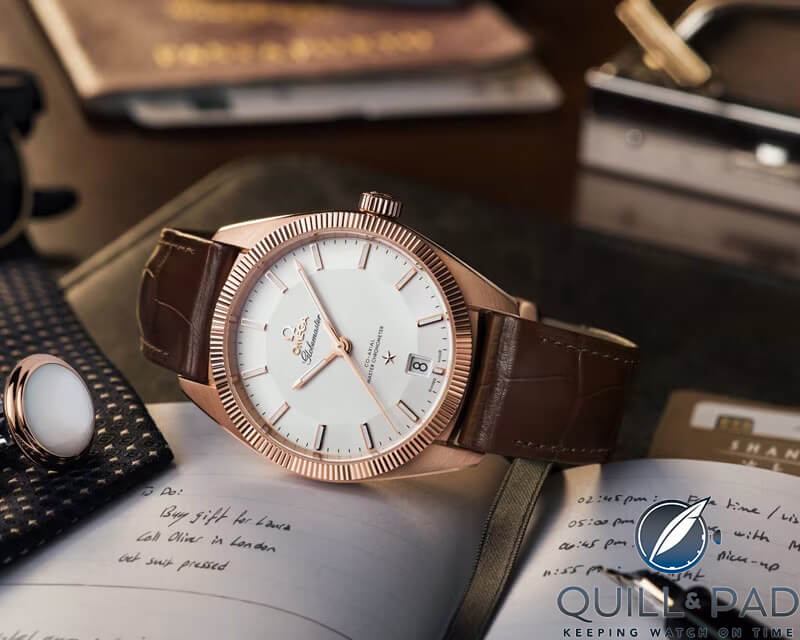
Omega Globemaster in gold
The name was chosen for its astrological meaning, symbolizing the predictable movement like that of a wristwatch. The 1950s era was defined by angular indices, pie-pan dials and a gold-applied star below the “Constellation” name while being some of the most accurate watches of the time. The next big update came in 1964 when the aesthetic took the form of the trends at the time. The case became C-shaped, and the indices became batons. and most notably it featured a fluted bezel.
Now, there are more details in the history of the Constellation, but these two design languages can be seen in the latest Globemaster. It sets the scene for why the subtly of the current version can be so appealing. It has a combination of the pie-pan dial with refined baton indices and a fluted bezel. The fluted bezel found on the stainless steel models is made from Tungsten – an extremely strong chemical element just below Diamond on the Mohs hardness scale.
Driving the watch is the caliber 8900, which was the star of the show upon release. Visible beneath the exhibition case back and well-finished like other Omega movements, it was the first METAS-certified movement, with a power reserve of 60 hours.
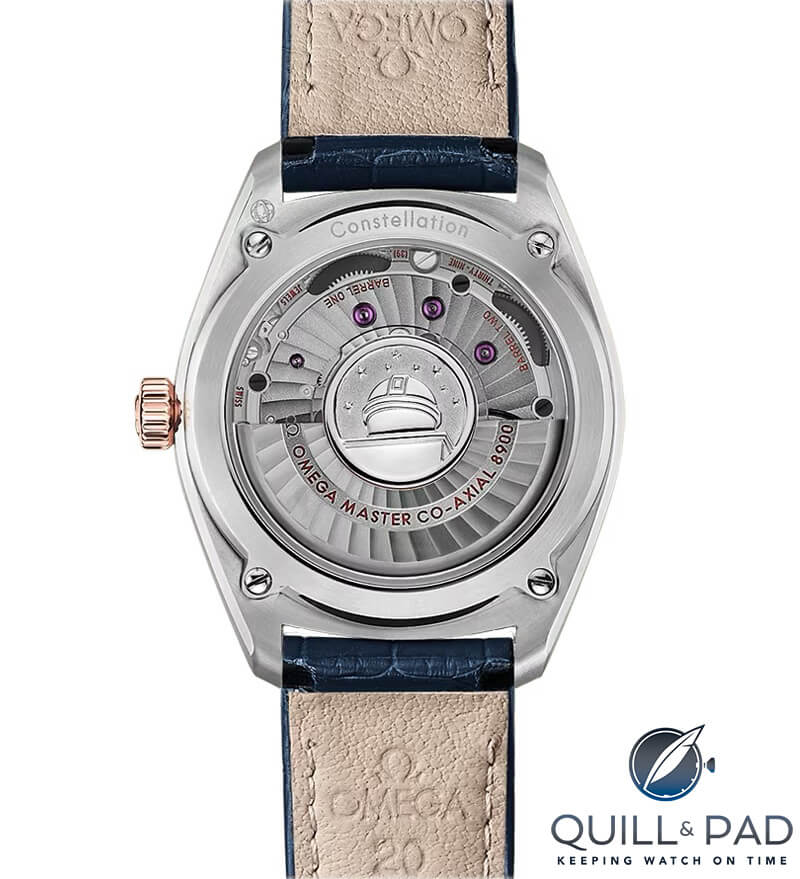
Back of the Omega Constellation Globemaster
At the center of the caseback you will find an engraved observatory inspired by the observatory timing competitions as found on the original models from the 1950s. The sum of small details in an elegant yet somewhat sporty package makes this arguably one of the most versatile watches from the brand. Is this the thinking person’s Omega?
For more information, please visit www.omegawatches.com/en-us/watches/constellation/globemaster/catalog
————————————————————————————————————–
—————————————————————————————————–
Zenith Pilot
The Zenith Pilot is going through a wave of attention right now given the brand just released the latest at Watches & Wonders 2023. This is understandable; however, I still believe this is already one of the best-kept secrets of Zenith. Why? Because so far, most coverage has focused on how reserved the time-only model is and even though the flyback chronograph has further visual interest and a big date, both are already offered well below RRP on Chrono24.
The first thought when thinking of Zenith is the classic El Primero Chronomaster Original and more recently, the Chronomaster Sport and Defy. However, the Pilot has a long, firm history within the brand.
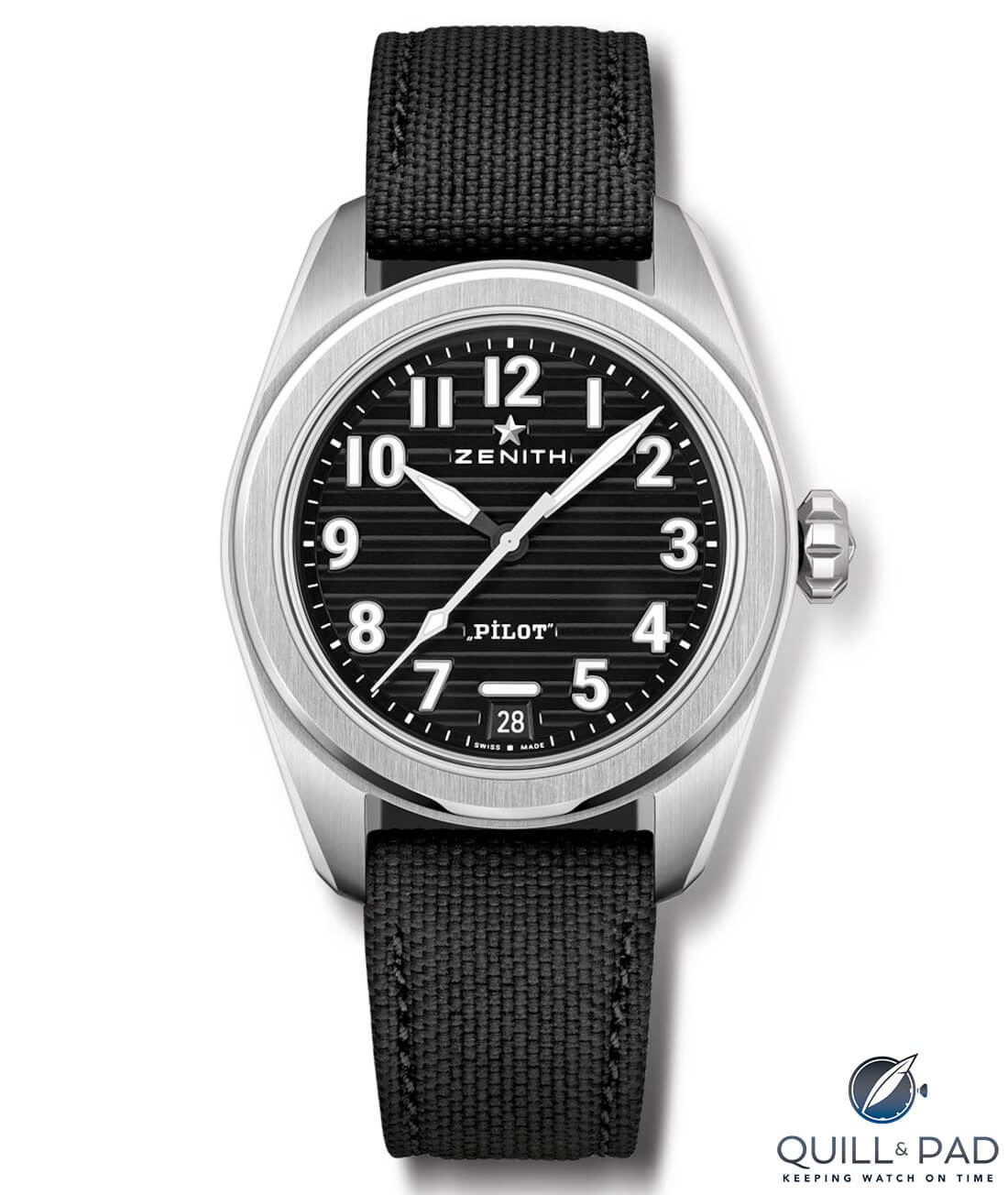
Zenith Pilot Automatic
The name PILOT (and PILOTe) was registered in 1888 when founder Georges-Favre Jacot was ahead of his time in expecting the importance of timekeeping to the profession. Cartier has a claim to the first wristwatch made for men when they produced the Santos for Alberto Santos-Dumont; however, as the first flight was made across the English Channel in 1909 by Louis Blériot, a Zenith was strapped to his wrist.
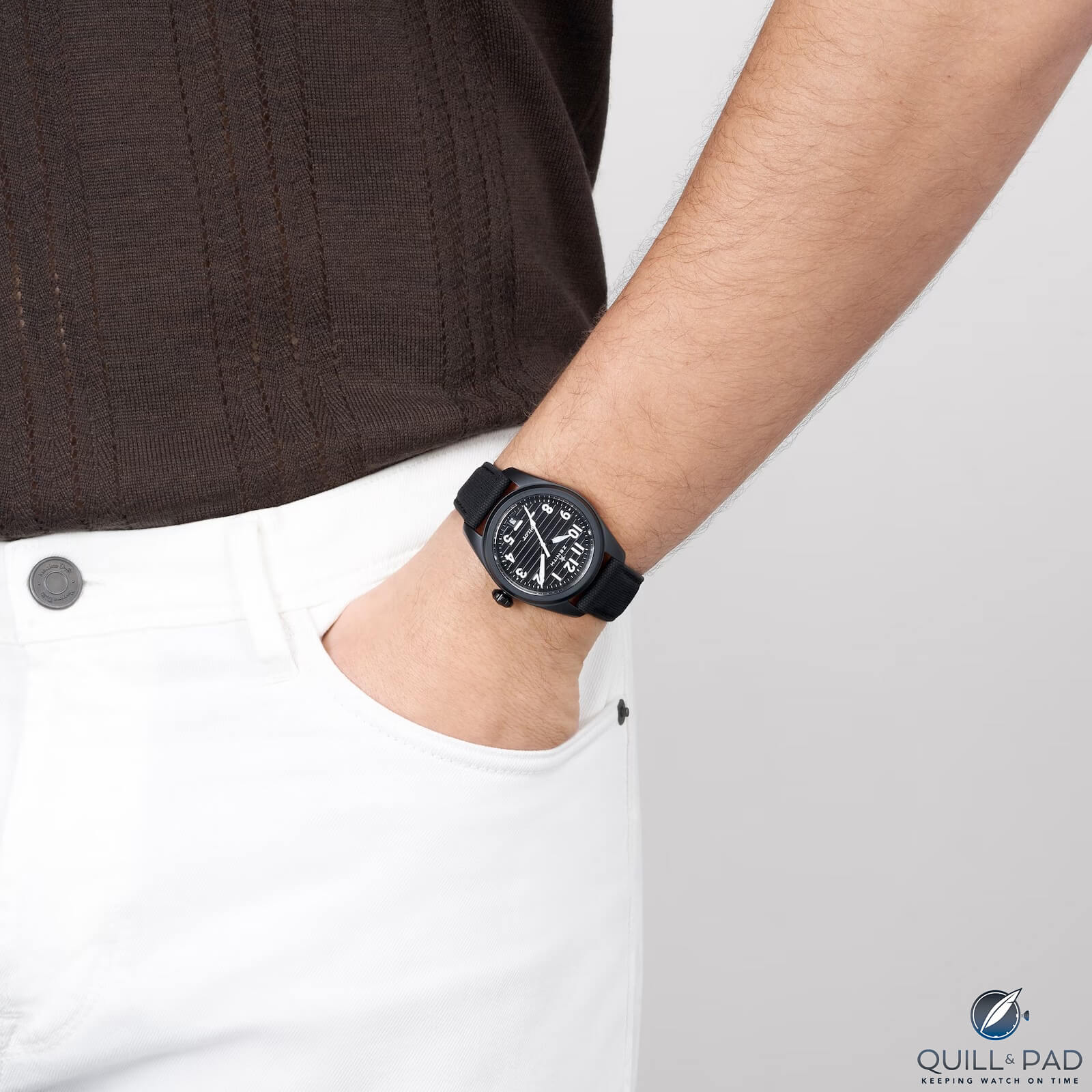
Zenith Pilot Automatic Ceramic
The styling was typical for the aviation watches of the time: fixed lugs, black dial with large Arabic numerals, chrome-plated case, and a big crown for easy adjustment. Zenith did not stop here as they began to produce aviation clocks, found primarily in French aircraft, and instruments in the 1930s such as altimeters and stopwatches. Zenith is known for their chronographs and the 1960s saw Zenith produce chronograph Pilot watches that found their way to the Italian military.
Jumping to the present, the new range is a much more modern offering, moving away from the previous models that were closer to those from Zeniths’ past. They managed to stick to the definition of a pilot’s watch, mainly the legibility angle with clear Arabic numerals on a black dial, while having a distinctly modern look that is more in line with the rest of the Zenith collection.
On top of this, the new watches are available in much more wearable sizes than previous iterations, as the time-only is 40mm and the flyback chronograph is 42.5mm, opening the door to a wider set of consumers who value the added factor of wearability. The dial has an interesting texture with horizontal lines and a well-positioned date window at the 6 o’clock position.
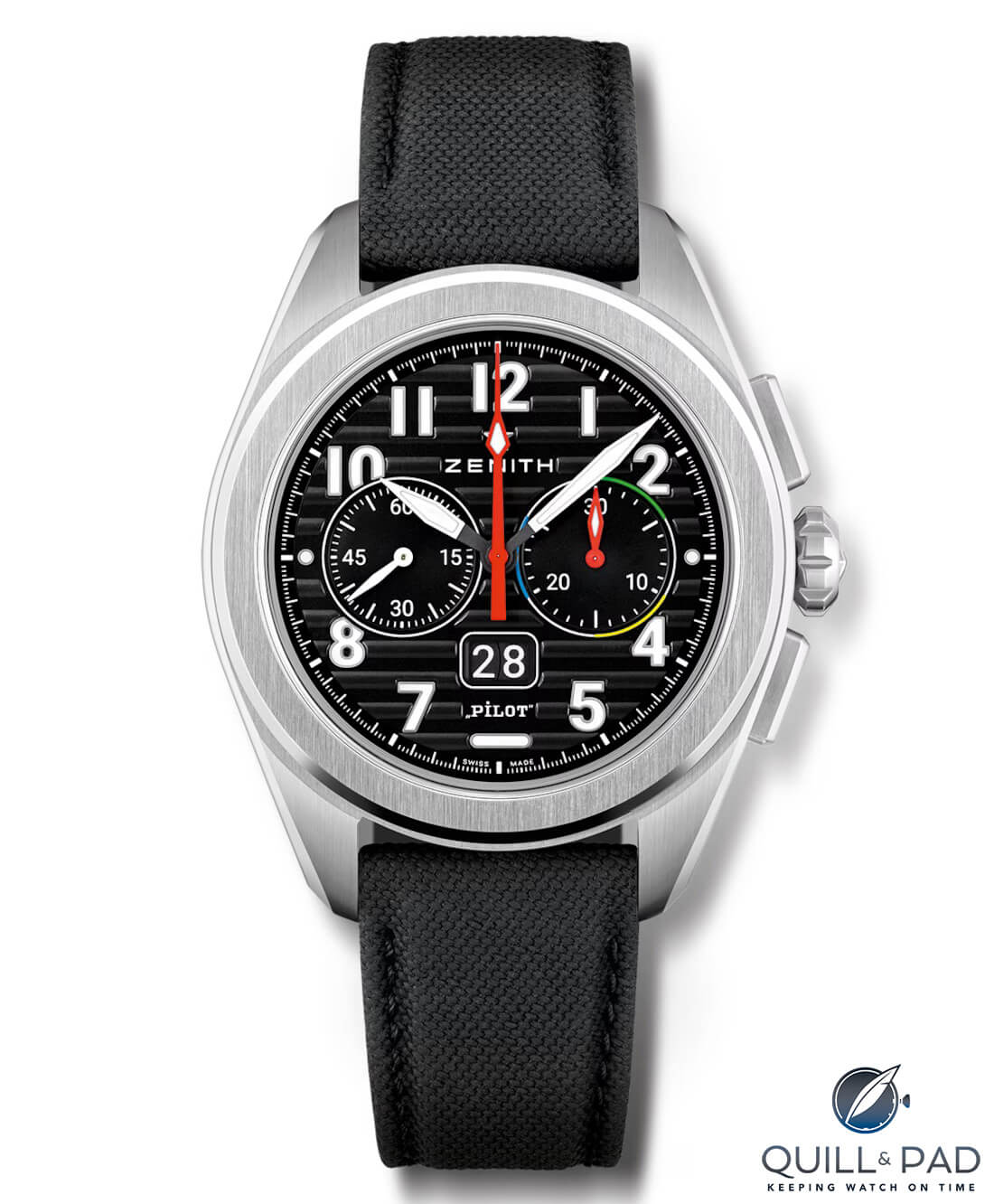
Zenith Pilot Big Date Flyback
The splash of color on the chronograph is tastefully executed, and the big-date function is a nice addition.
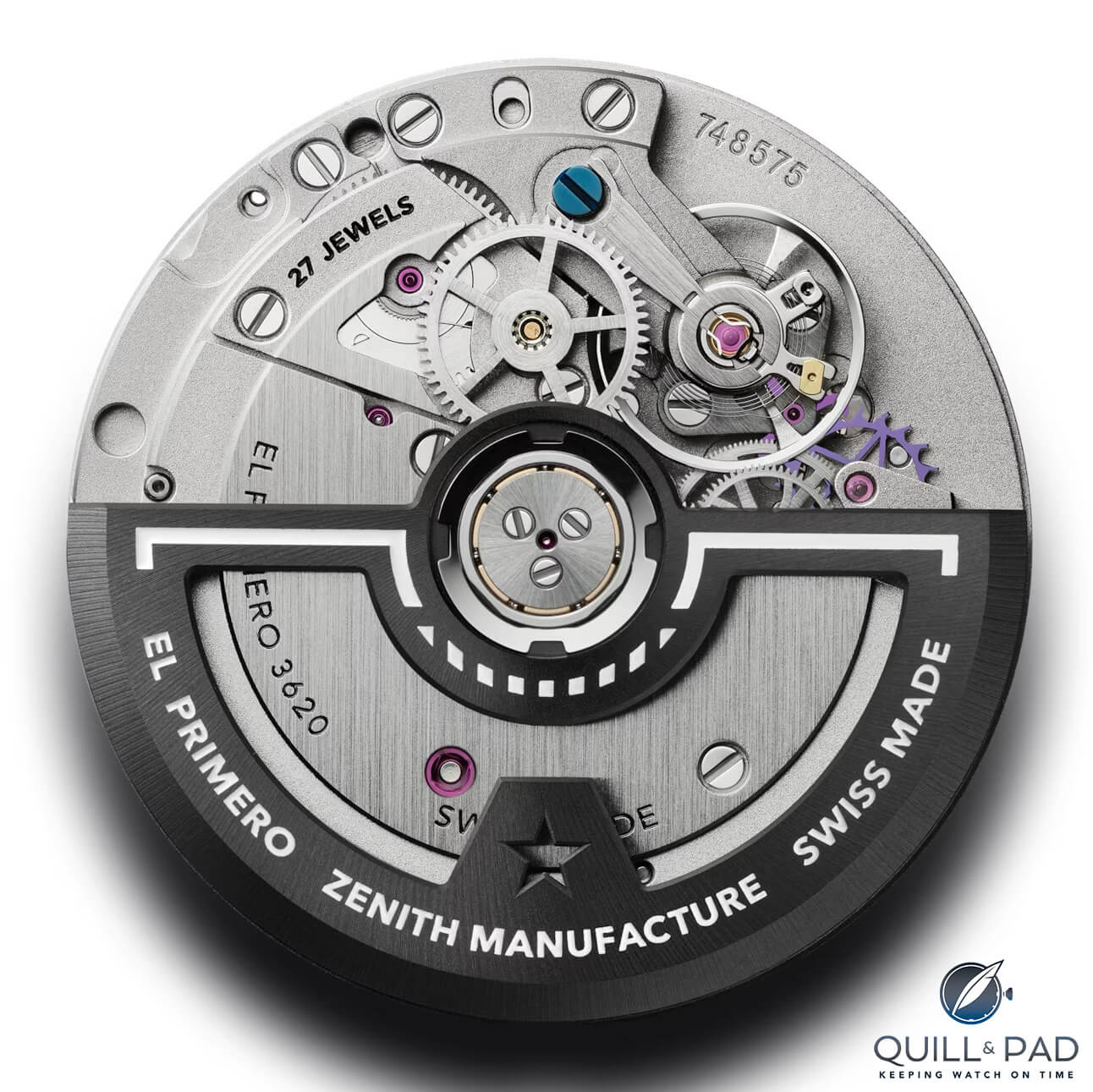
Zenith El Primero Caliber 3620
Finally, as it is a Zenith, you should find the El Primero high-frequency movements driving it appealing. Zenith has greatly improved the Pilot collection and I now find the Pilot just as desirable as other modern pieces from them.
For more information, please visit https://www.zenith-watches.com/en_us/products/pilot
—————————————————————————————————–
—————————————————————————————————–
IWC Portofino
IWC are known for their simplicity and functionality, and this can be seen in its most popular collections – the Big Pilot, Mark series and Portugieser. However, the Portofino is rarely spoken about, yet the range holds to the IWC philosophy. Given that, it could be an alternative entry into the brand beyond the Mark series and provide you with the IWC charm, without the price tag of a Portugieser.
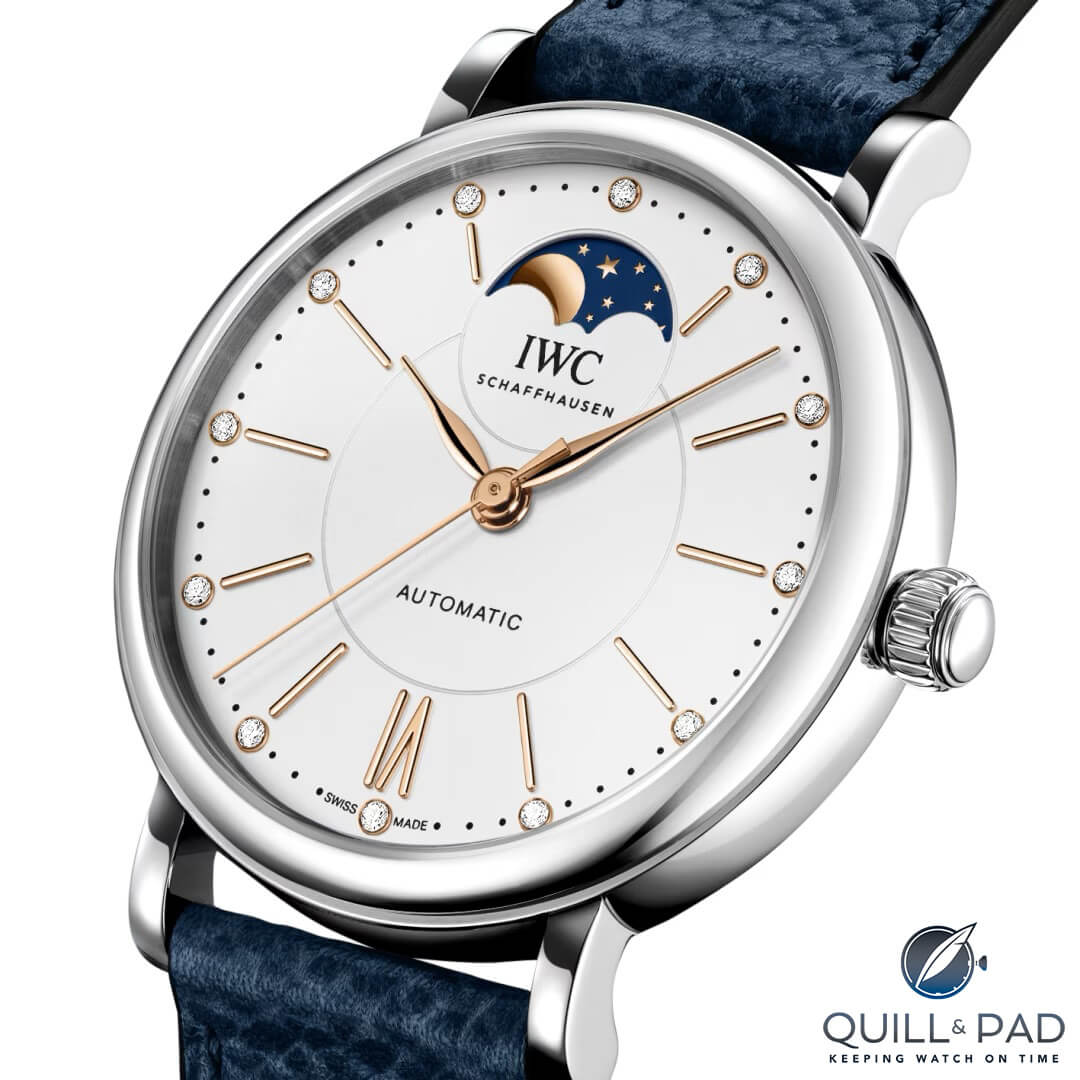
IWC Portofino Automatic Moonphase
The Portofino was initially launched in 1984, making it one of the newest ranges within the IWC collection. To stand out from the quartz crowd, popular at the time, IWC decided to look to the past rather than the present for inspiration and drew it from pocket watches produced by Lepine in the 1800s. By doing so, the model featured very classic design elements such as a white dial, Roman numerals, Breguet hands and a moonphase complication, all housed in an oversized case.
In the 1990s, the watch evolved closer to what we see today as it become more minimalistic with gold stick indices and hands in the smallest case IWC had produced to date.
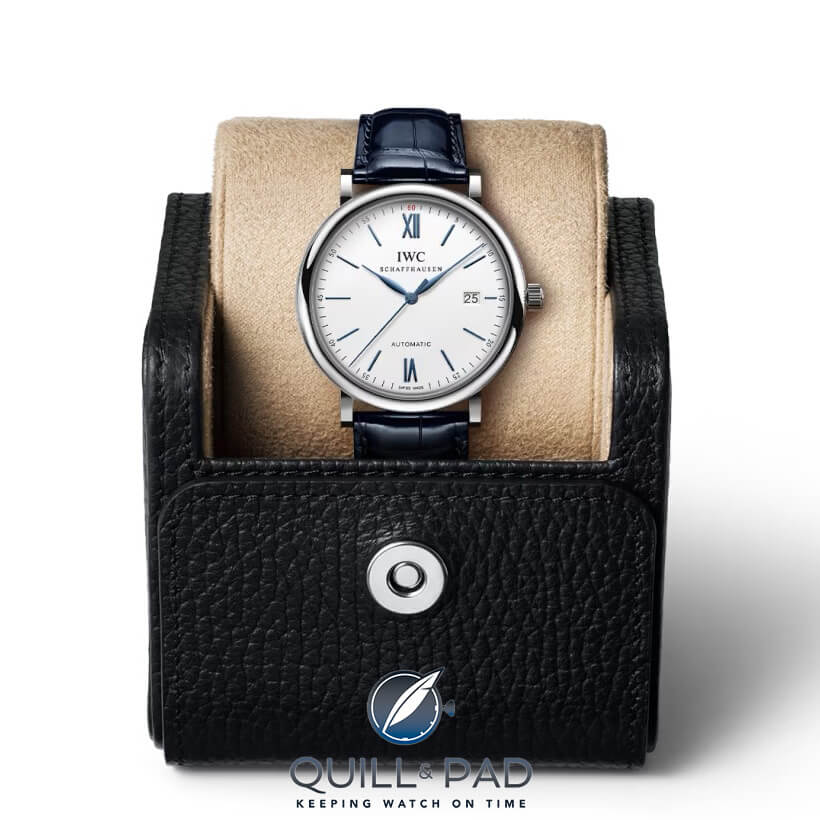
IWC Portofino Automatic
The modern Portofino manages to combine both styles in an understated package. It is a smaller, dressier option from the brand coming in 34/37/39/42mm case sizes with various complications on offer. As it has a more formal personality, it can be compared closer to a Portugieser than other models. The round case continues to offer a traditional, vintage aesthetic inspired by the 1980s Portofino. Interestingly, the Portofino is a newer collection than the Portugieser, yet it more closely resembles watches from the past.
The lugs are broken from the case rather than being seamlessly built into the case. The dial is very well-balanced, featuring minimal text and Roman numerals at the 12 and 6 positions with stick indices elsewhere. Despite being a dress watch, it manages to have a robust feel on the wrist mainly coming down to the size and solidity of the case meaning it might not be as formal on the wrist as you first expect.
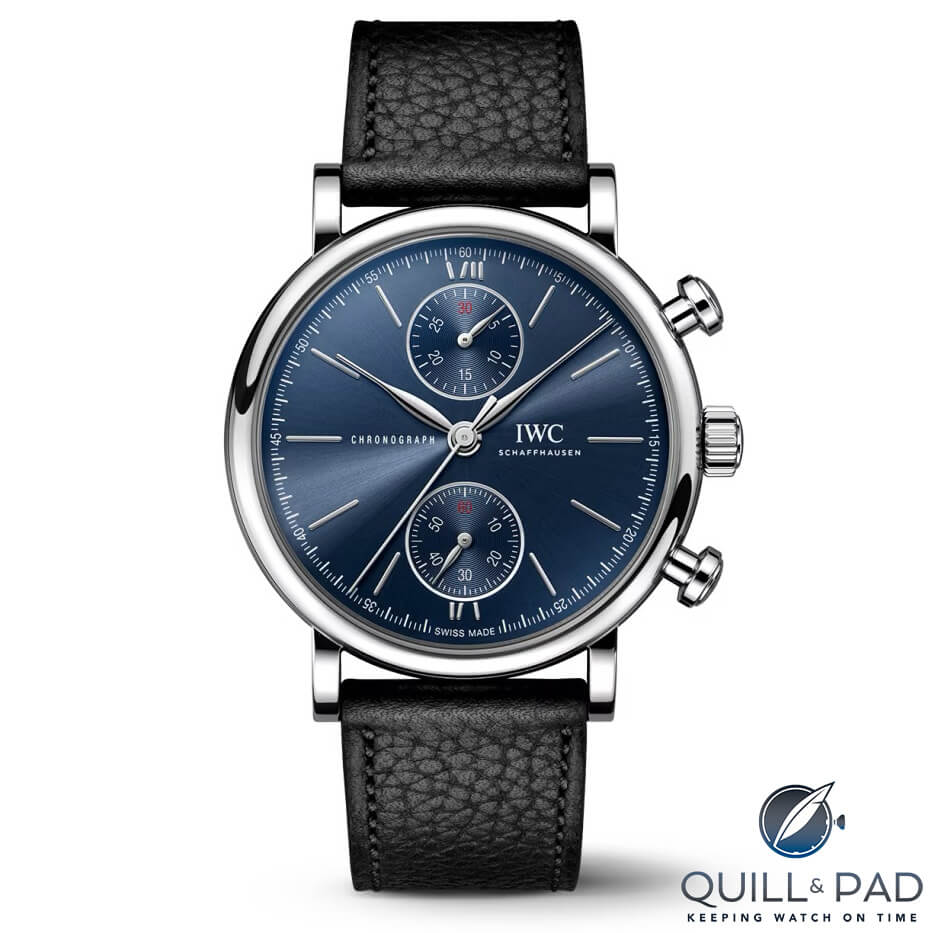
IWC Portofino Chronograph 39 Edition “Laureus Sport for Good”
With prices starting at below £4,500, it is a very compelling package, especially as prices are rising across the industry and you are buying into one of the most effortlessly cool brands out there. My pick would be the blue dial 39mm chronograph.
For more information, please visit www.iwc.com/us/en/watches.html#%7B%22collection_filter0%22%3A%5B%22ocp%3Aiwc%2FCollectionProductLine%2FCOLL_PORTOFINO%22%5D%7D
—————————————————————————————————–
—————————————————————————————————–
Jaeger-LeCoultre Duomètre
When you reach the higher levels of horology, there are naturally more watches that fall under the radar as production numbers are fewer and there are more unique options. When considering the large brands, most are still aware of the ranges that are offered at this level. Just think of examples from Rolex, Patek Philippe or even A Lange & Söhne – the majority receive a good amount of coverage and would be known to a broad spectrum of the watch community.
JLC on the other hand, is most widely known for the Reverso, Polaris, and Master Control, but in their collection remains the Duomètre.
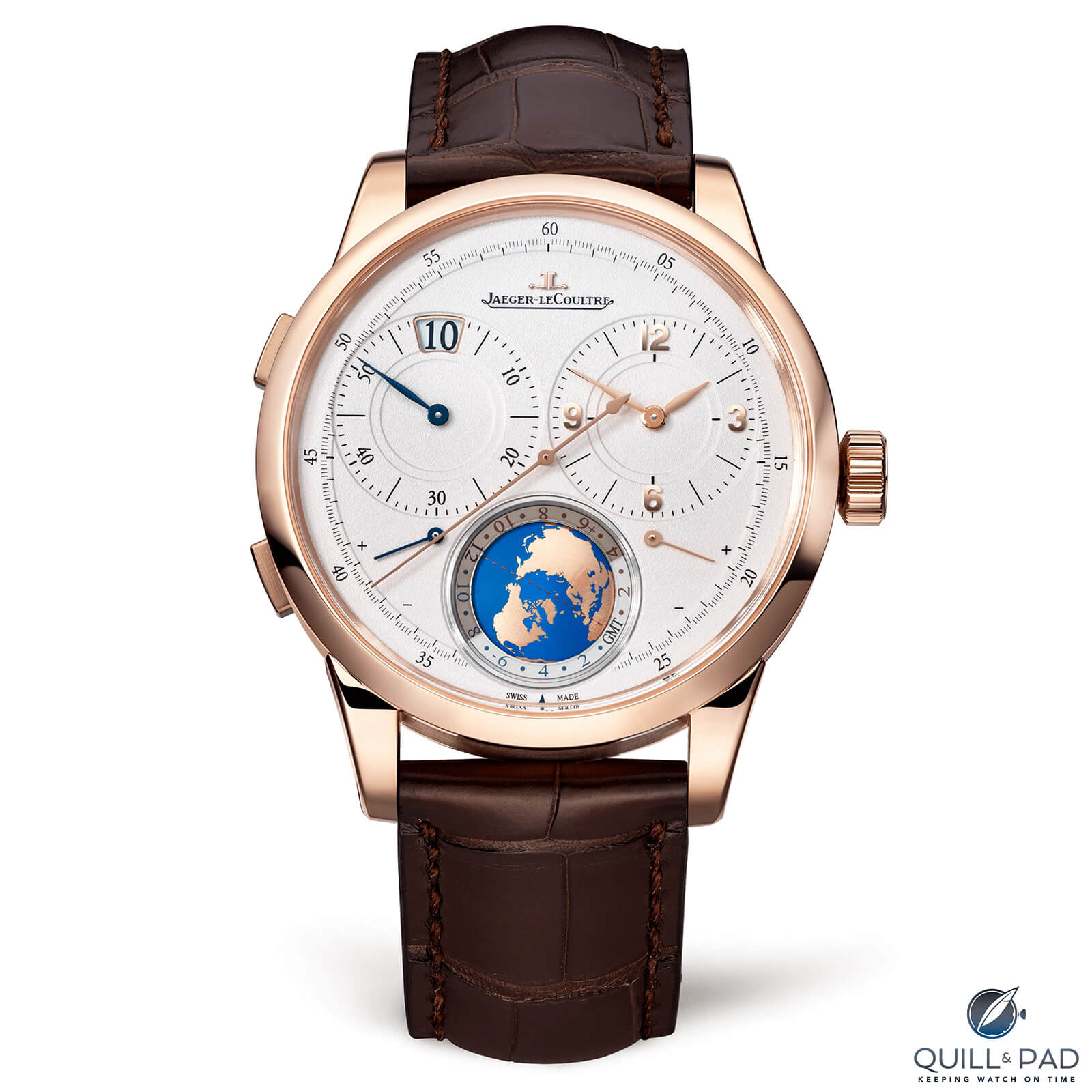
Jaeger-LeCoultre Duomètre Unique Travel Time
The Duomètre is something to behold. Bringing together a sense of tradition and innovation, in my opinion JLC quietly produces one of the most intriguing watches for the money. The Duomètre was launched in 2007 and highlights the watchmaking abilities of the brand known to be the “watchmaker of watchmakers”.
The movement is something distinctive as it features JLC’s Dual-Wing concept bringing together two separate barrels in one case. One is used solely for timekeeping by regulating the balance and escapement and the other is used to power the hands and complications. When adding complications to watches, the power from the winding barrel is lowered as it is used for varying functions.
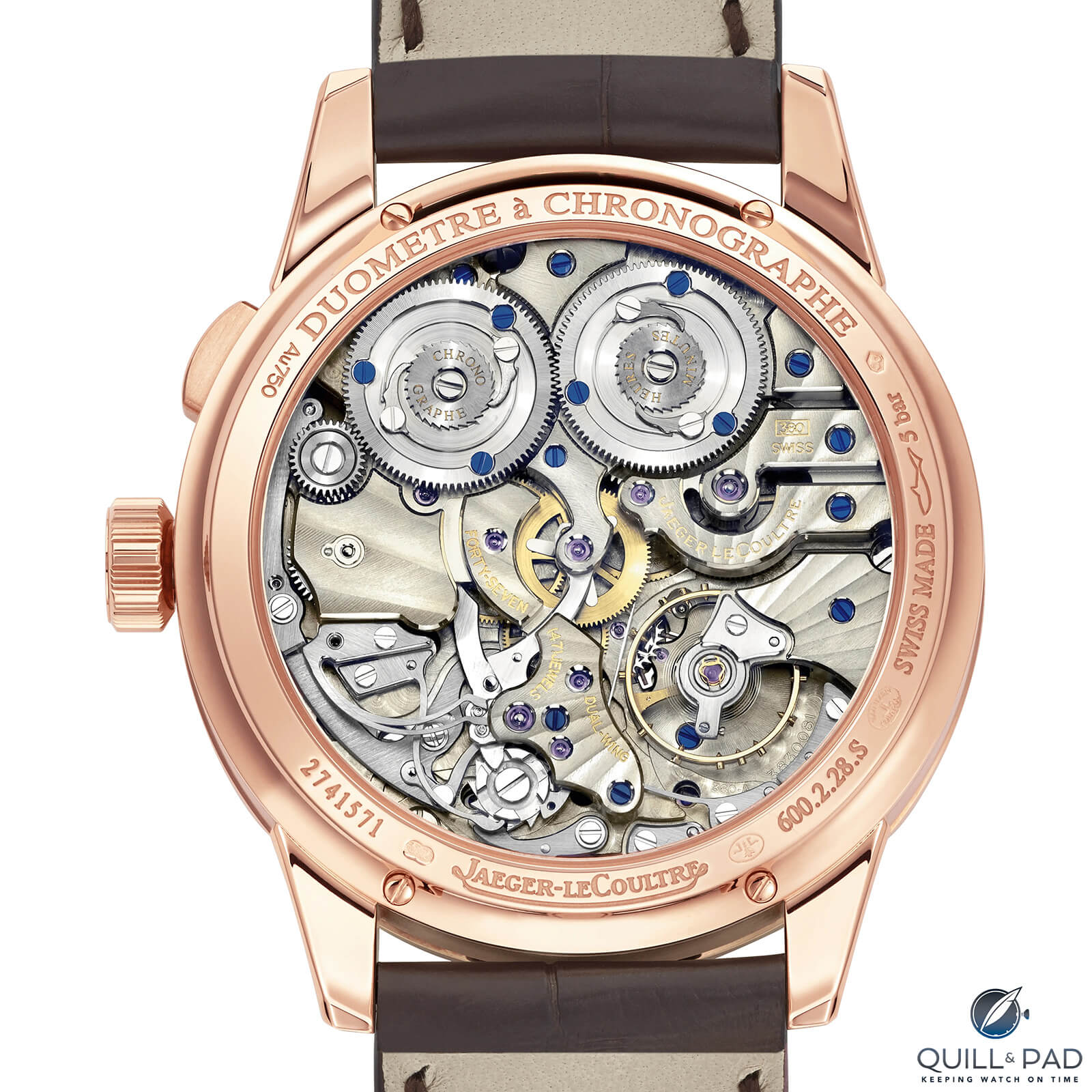
Back of the Jaeger-LeCoultre Duomètre Chronograph
By having an extra mainspring, the watch can achieve greater levels of accuracy. Interestingly, when you hack the seconds by pulling out the crown, you will still see the balance beating. This is to mitigate any loss in accuracy as restarting a balance requires it to get back up to speed (putting this very simply). Small considerations that JLC has gone to the lengths of solving.
The design can be defined as a dress watch; however, the dial layout revolves around the movement. It is all about balance and symmetry. Some models have various complications, but you will typically find two main counters that reflect the two drivetrains. One will display the time and the other varies depending on whether it has a chronograph or moonphase complication for example.
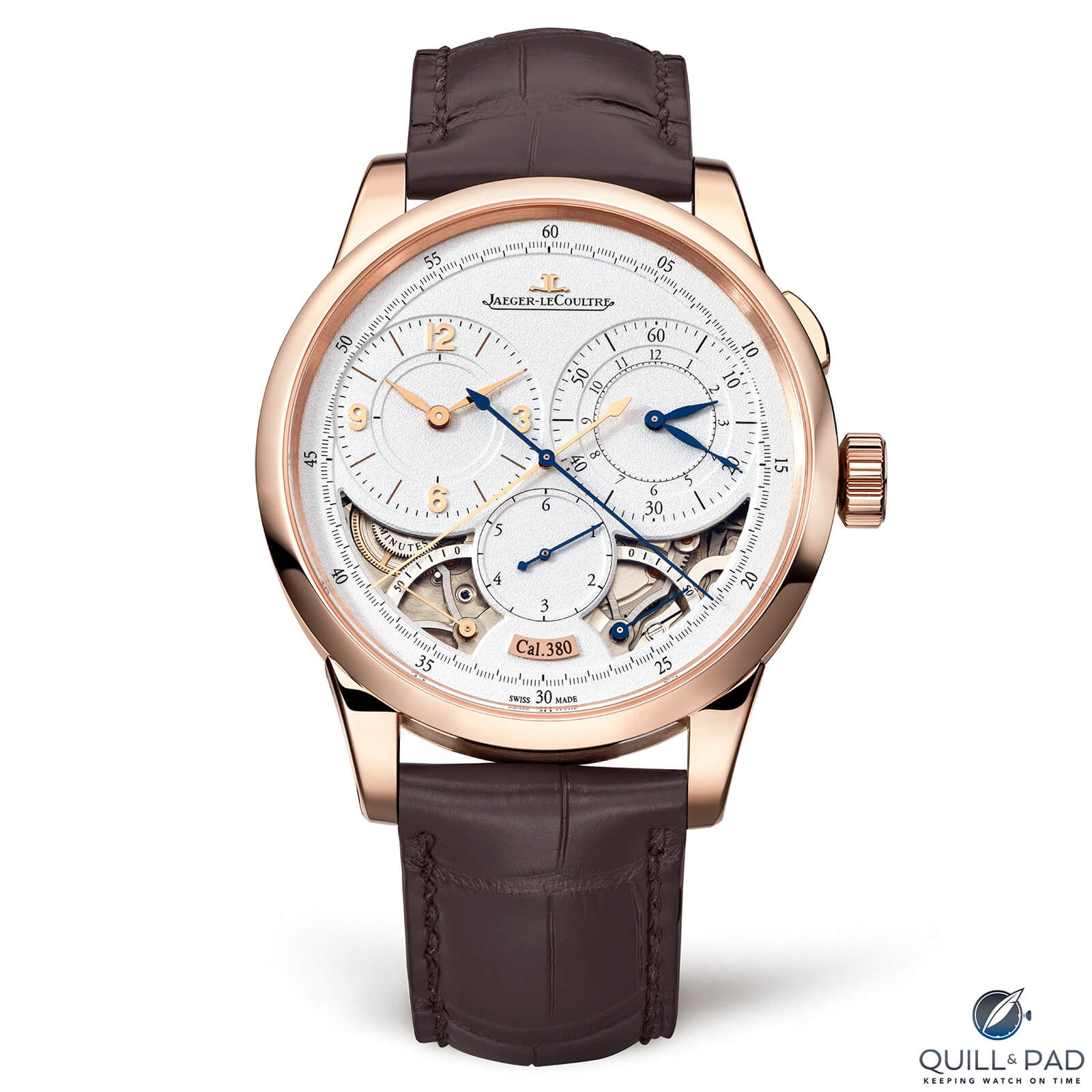
Jaeger-LeCoultre Duomètre Chronograph
Beneath, you will find two separate power reserve indicators, one for each drivetrain that in some references are found over an open-worked dial. At the center is a 1/6 of a second counter. The finishing is all as you would expect from a JLC at this level with various case finishes, a finely textured dial and movement decoration that can be seen through the exhibition case back.
It is a stunning watch that manages to evoke a great deal of emotion, and depending on the year and reference, it can be purchased for the same price as a Rolex Daytona on the secondary market. Even removing my bias as the Duomètre has been on my grail list for some time, it provides a level of high horology from one of the largest brands and at present does not receive the attention it deserves.
For more information, please visit www.jaeger-lecoultre.com/us-en/watches/duometre
Cartier Ballon Bleu de Cartier
Cartier requires no introduction, producing some of the best-known watches on the market including the Tank and Santos. Given the watchmaking history of Cartier and Art Deco design philosophy, it is easy to appreciate why Cartier watches tend to be square or rectangular in shape. The Ballon Bleu de Cartier is different. It stands out in the Cartier catalog by having a round case. Launched in 2007, the Ballon Bleu is one of the newest collections in the Cartier catalog.
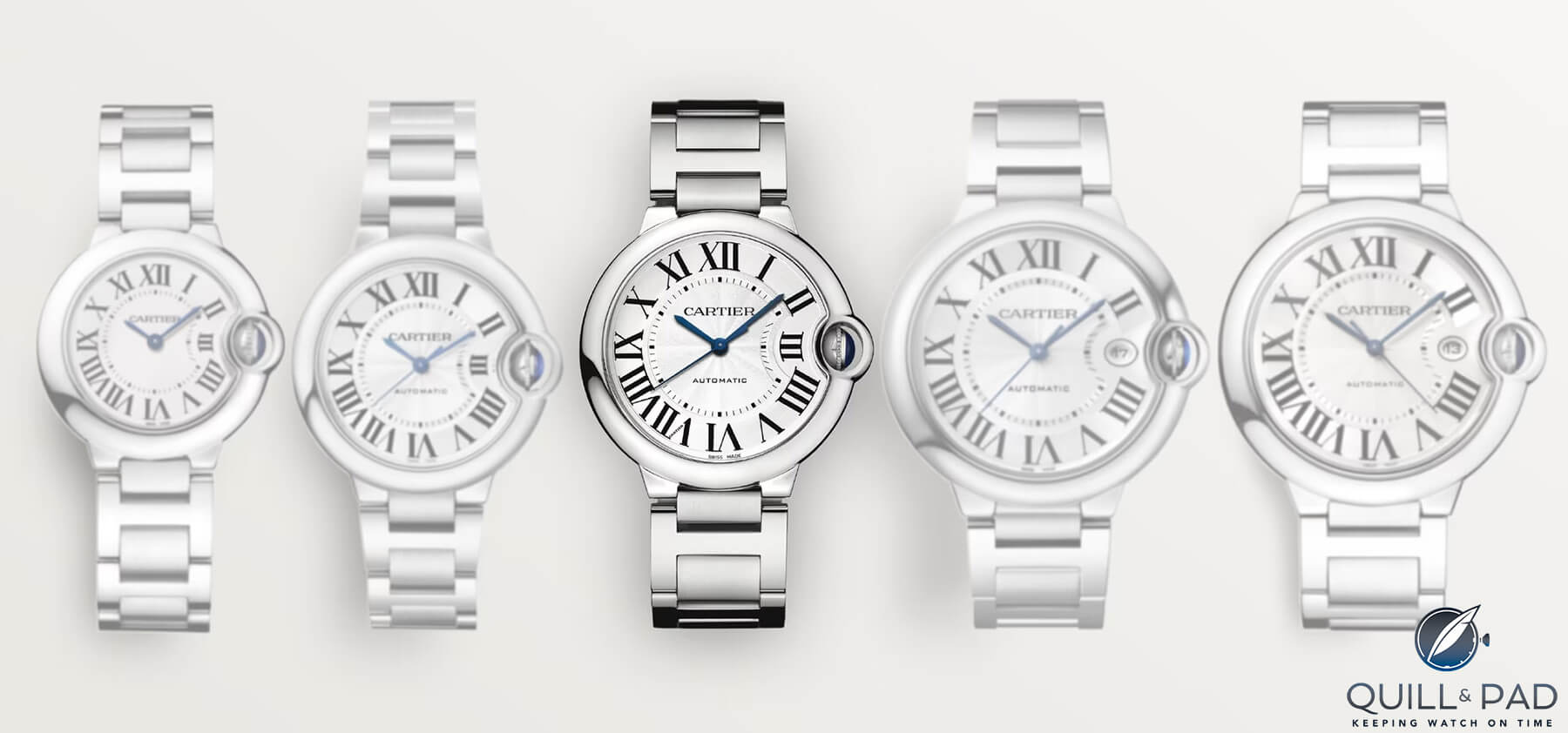
Different sizes of the Ballon Bleu de Cartier
Cartier always stood out for creating interesting case shapes such as the square yet integrated Santos and the coveted Crash, which feels like it came straight from Salvador Dali’s artwork. However, Cartier grabbed everyone’s attention with the Ballon Bleu because the watch was round. It maintained the typical design elements of the brand, including Roman numerals, railroad minute markers and white dial, although there have been other colors added since.
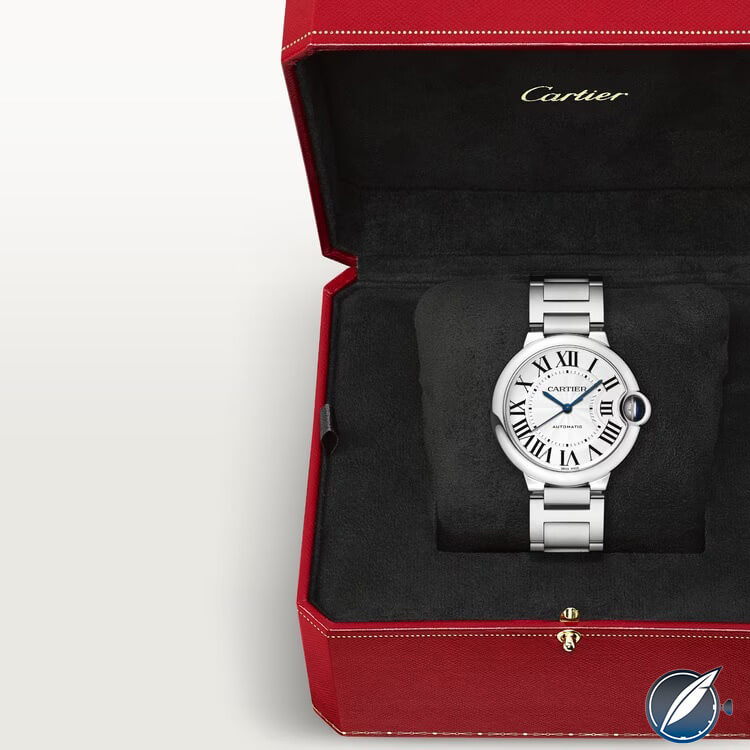
Ballon Bleu de Cartier 36mm
It quickly became a hit and one of their most popular models, defining the late 2000s era for Cartier. Since, interest has moved on and it has lost some novelty but that does not make it a less appealing package today. The Ballon Bleu is offered in various sizes from 26mm up to 42mm, meaning you will be able to find the right size for you. However, the unique pebble-like case shape and short lugs result in a short lug-to-lug measurement making them very wearable on the wrist.
Both the sapphire crystal and caseback are domed adding to the overall pebble feeling of the watch. Now, the Ballon Bleu does have a round case but that did not stop Cartier from adding some of its flair. This can be mainly seen around the large blue sapphire-topped crown, which is somewhat integrated into the case providing extra protection.
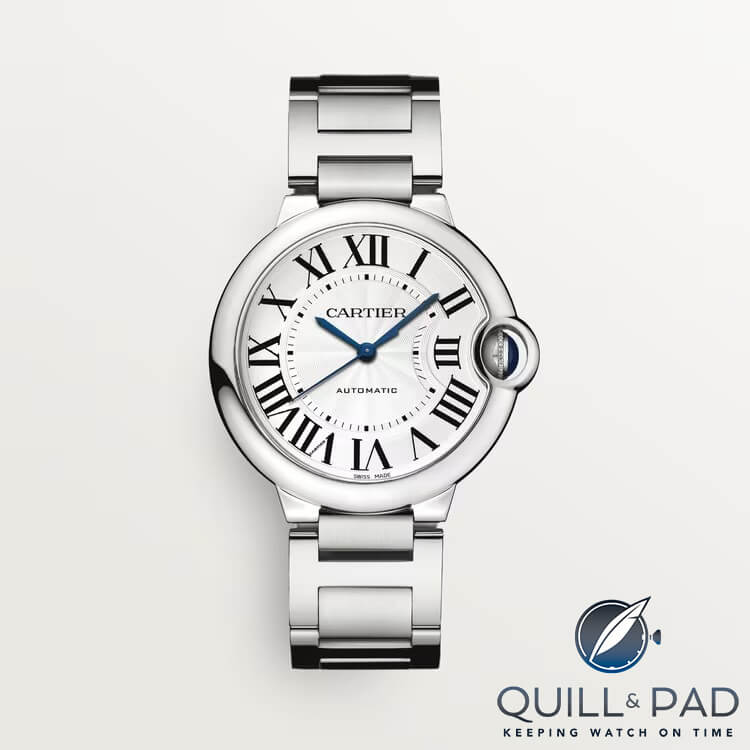
Ballon Bleu de Cartier 36mm
This design aspect is then further felt on the dial where at 3 o’clock you find an indent that is mimicked by the minute track. This was not necessary for them to do, but it adds a hint of asymmetry in an otherwise completely balanced watch. Within the dial, you will find the center has a guilloche pattern on most, further breaking the dial down and making it more visually interesting.

Ballon Bleu de Cartier 36mm on the wrist
This falls under the dress watch category, yet it still manages to be versatile like many other Cartier models. Somehow, Cartier manages to take a dress watch formula and produce it in such a way that it still fits in more casual situations.
Despite the Ballon Bleu no longer being the “It” watch from Cartier, falling into the shadows of the Tank and Santos, it is still a prominent piece in the collection. Everything that once made it extremely popular remains and in the world of Cartier, where square is standard, by opting for the round option you are deciding to be different.
For more information, please visit www.cartier.com/en-us/watches/collections/ballon-de-cartier/
—————————————————————————————————–
—————————————————————————————————–
Blancpain Air Command
Blancpain is known for creating the first modern diving watch and setting the standard for the industry in the early 1950s. This standard was followed by the biggest brands out there when producing their diving watches, namely Rolex with the Submariner. Blancpain receives some recognition for this, but on the whole, the brand still deserves more given how great their watches are.
The Fifty Fathoms is the natural entry point to the brand, but when you look deeper into their collection you will find the Air Command. This model is a modern iteration of the military aviation pieces Blancpain produced in the 1950s. The Air Command story is somewhat vague and that alone adds to the allure of the model. It starts in the 1950s when the French Ministry of Defence created the Type 20 standard for chronographs they could use. The set of requirements included a black dial, flyback function, small seconds and lumed indices.
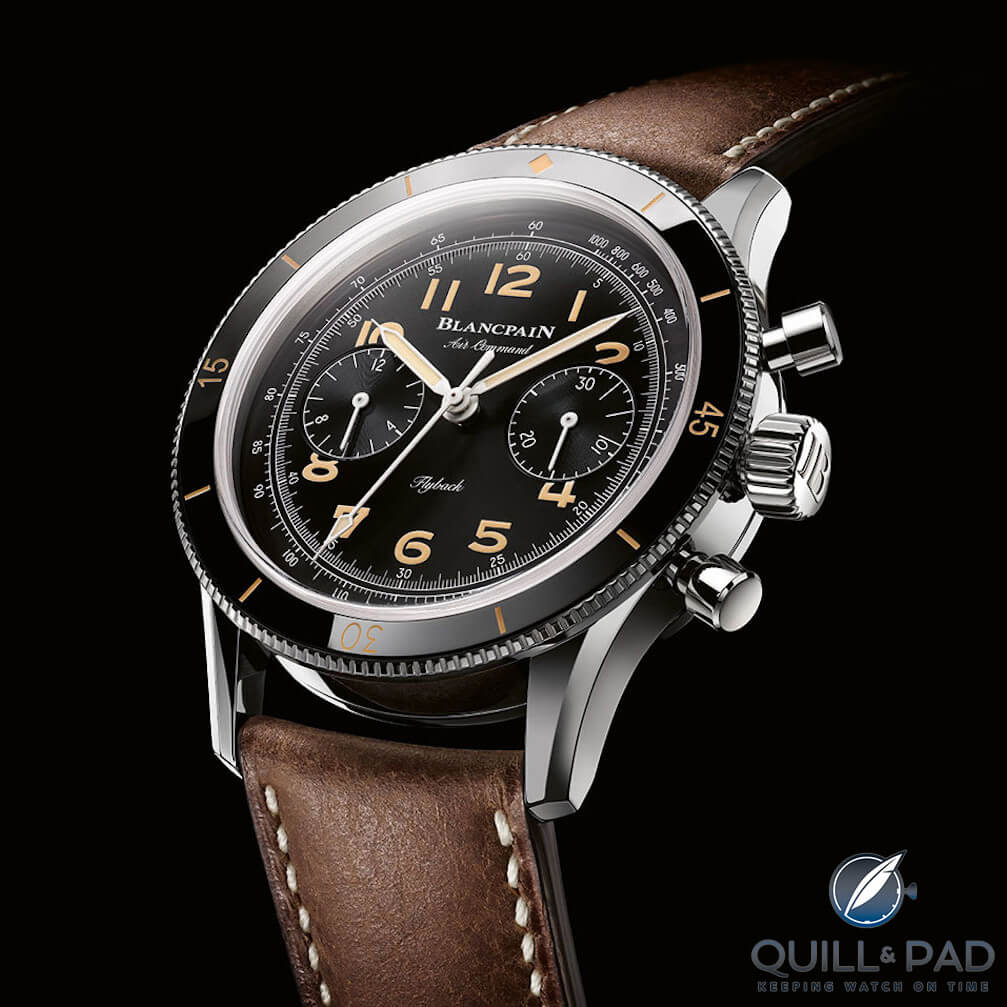
Blancpain Air Command with black dial
Blancpain did not end up supplying the French military, that fell to Breguet with the aptly named Type XX. However, as Blancpain was supplying the Fifty Fathoms to the American Navy, they created a chronograph for them to try and hopefully achieve the same success. A handful of Air Commands were produced and delivered, but they were technically prototypes. According to Philipps Watches, the model was never commercialized, and the overall numbers were extremely limited.
In 2019, Blancpain decided to revive the name and produce a re-edition that paid homage to the original. It was a limited-edition piece that followed the exact requirements set by the Type 20 standard. This resulted in a flyback chronograph with a black dial and accurate details such as the Arabic numerals, bi-compax layout, pilot hands and even the dial tachymeter.
While retaining many original details and proportions, the new model brought modern case finishing and movement as expected. The case is 42.5mm in diameter and 13.8mm thick, featuring beveled edges and chamfered lugs. The bi-directional bezel is another throwback to the original and is a black ceramic insert with lume.
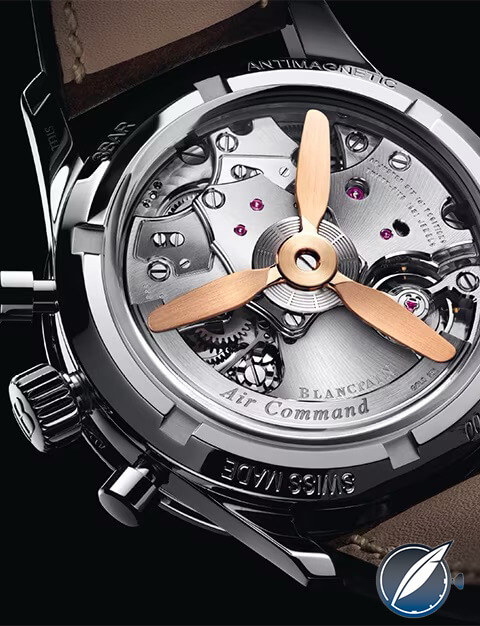
Propeller rotor of the Blancpain Air Command
Turn the watch over and you will see the caliber F388B nicely decorated, although the rotor is what stands out. The gold rotor is propeller-shaped and fits extremely well with the story behind the Air Command, as well as allowing a more even view of the rest of the movement.
Beyond the 2019 limited edition that proved very popular, Blancpain followed up by launching permanent references to the Air Command range. In 2021, they launched the blue dial variant in both titanium and rose gold. This retained all the details that made the 2019 limited edition a success, although the movement rotor is no longer propeller-shaped, replaced with a more traditional skeleton design.
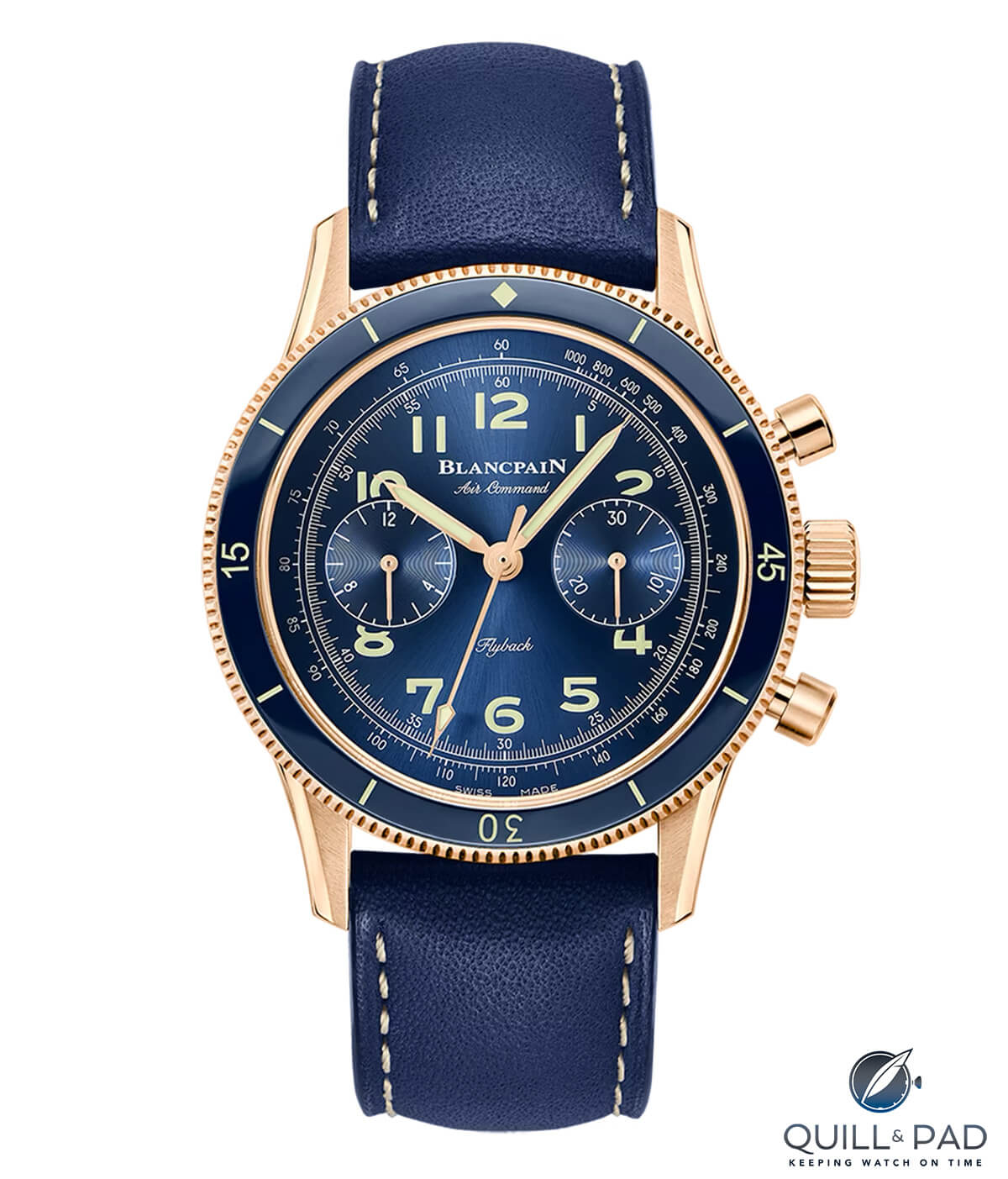
Blancpain Air Command with blue dial
However, going for the blue dial option, the watch took on a more modern aesthetic. Notably, Blancpain decided to build out the Air Command range further in 2022 by offering smaller 36mm case options that are also thinner. Once again, all details remain present, and they have been proportioned well so there has been no loss of charm when moving to the smaller size.
The biggest issue with the modern Fifty Fathoms, the typical entry to the brand for new customers, is the size remains large at 45mm. The Air Command is the less obvious Blancpain to consider, however at 36mm and 42.5mm sizes, it can be a more wearable piece whilst allowing you to buy into the brand and its heritage.
For more information, please visit www.blancpain.com/en/air-command-collection
Girard-Perregaux 1966 – Orion Trilogy
Girard-Perregaux is best known for its Laureato collection, a modern integrated sports watch born in the 1970s, and its Bridges haute horology pieces. Another staple in their collection, however, is the 1966 range. It is a subtle collection of dress watches that focuses on simplicity and pure watchmaking. In their own words, when it comes to the 1966 collection they are focusing on producing timelessness.
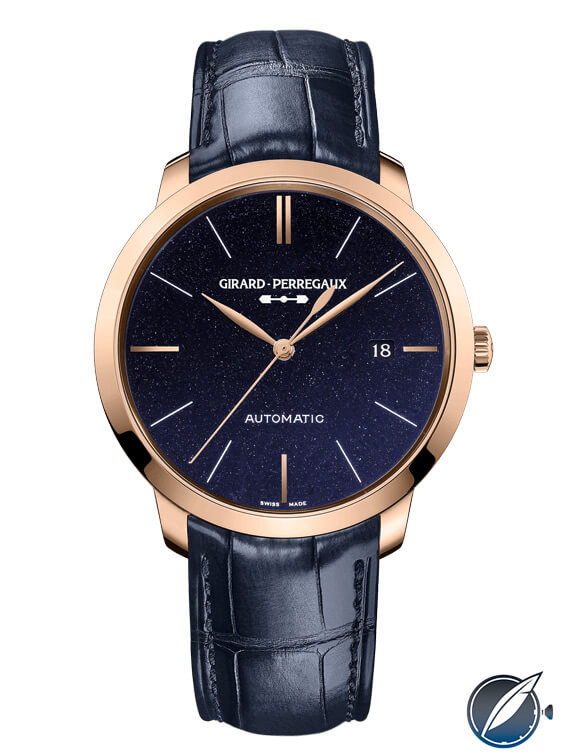
Girard-Perregaux 1966 Orion with aventurine dial in pink gold
Better still, despite being a Girard-Perregaux, they are fairly priced and even more convincing when looking at the secondary market. The 1966 collection references an important year for the brand. It was at this time Girard-Perregaux released its first high-frequency movement, beating 36,000 vph known as the Gyromatic HF. This was only achievable thanks to their in-house team focused on movement development. The movement was well-recognized, winning awards including the coveted Neuchâtel Observatory Centenary Prize.
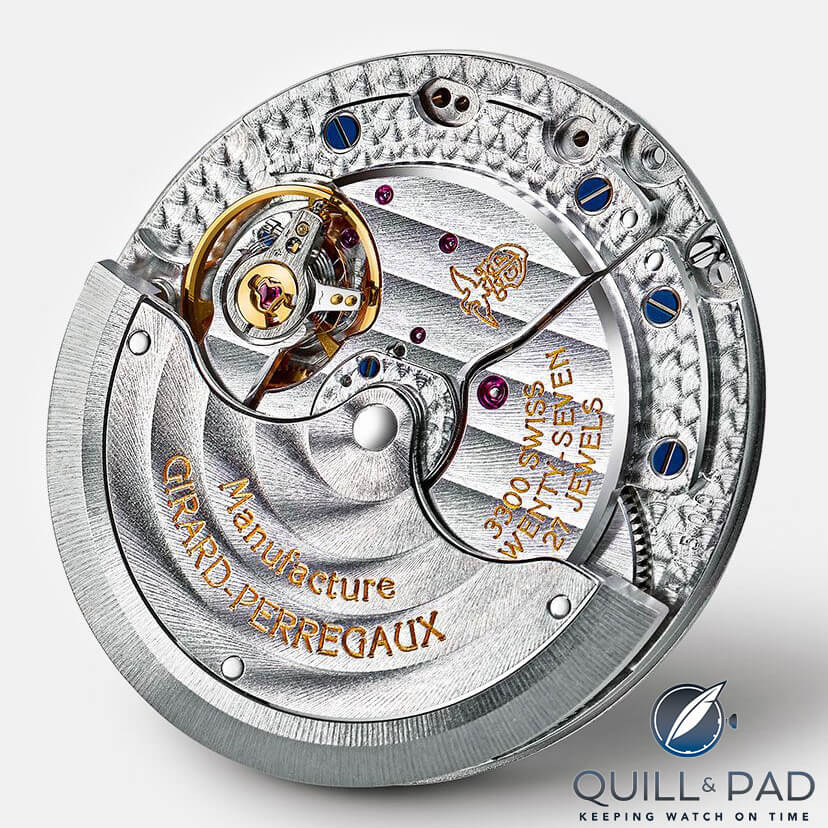
Girard-Perregaux Calibre GP3300
A year later, the majority of all chronometer certificates issued were to the Girard-Perregaux high-frequency movements. The design used to showcase this movement was as understated and elegant as it is today. The current 1966 offers various references in different sizes ranging from 30mm to 40mm in diameter, case materials and complications.
The references I want to highlight are part of the Orion trilogy, launched in 2020. What makes these three variants stand out are their aventurine dials, resembling a sky full of stars (hence the Orion naming). The trilogy is offered in stainless steel or rose gold with a blue dial or black DLC steel with a black dial for a monochromatic aesthetic. The pattern has a sparkle to it and under the light it is captivating to look at.
The references all follow the formula found in the rest of the 1966 collection with a 9.4mm thin, well-finished case.
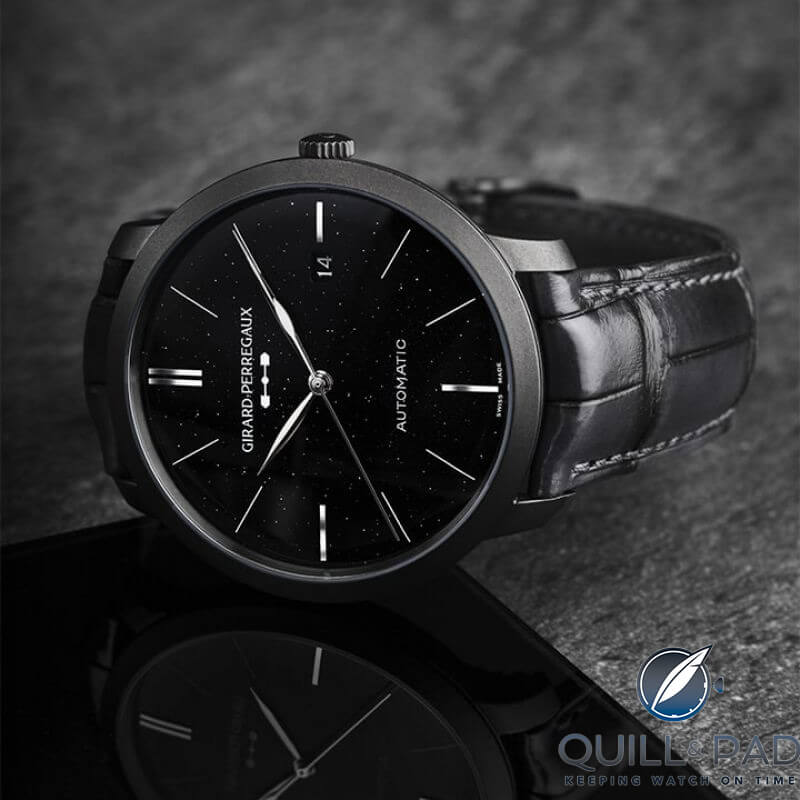
Girard-Perregaux 1966 Orion with aventurine dial in DLC steel
The crystal is domed and only visible from the side profile, adding further depth to the watch. Elegance is further instilled by the leaf-shaped hands and fine indices that look as though they are the lines connecting a constellation. It is powered by the reliable, in-house GP3300 movement and finished to a good standard with beveled edges, engravings, and Côtes de Genève. It is the base that other brands such as MB&F use for some of their own such as the HM5.
By opting for an Orion reference, you are buying into a very well-respected brand that offers the Aventurine experience at a more affordable price point than some of the well-known competitors, namely the A. Lange & Söhne Saxonia.
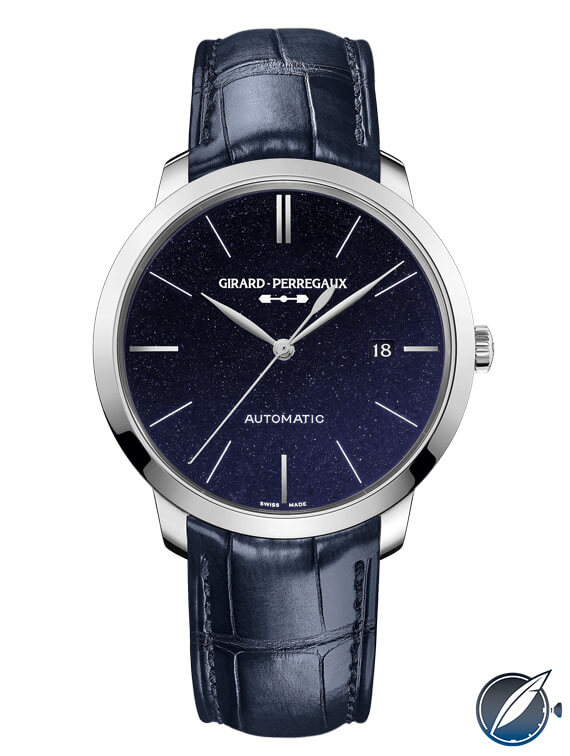
Girard-Perregaux 1966 Orion with aventurine dial in stainless steel
The stainless steel Orion has an RRP of £8,600 at the time of writing. Understandably, the case material difference is the main driver of price disparity, but the Girard-Perregaux is a very solid option for those captivated by the charm of the dial effect.
For more information, please visit www.girard-perregaux.com/row_en/collection/1966.html
Conclusion
Some watches are true icons and are recognized by a wide audience. Coverage of the watch industry grows with each year and as more people become captivated, these pieces only become more popular. Even as media coverage broadens, there are still some models that fly under the radar. These pieces offer a chance to buy into a brand whether it is for the quality, aesthetic, or heritage.
They are in some ways the best-kept secrets. By being so, they can be a more individual option compared to their more famous siblings and provide attractive value for money. The watches listed here are all interesting propositions and I want to make sure you are aware of them as you never know, one could be your next watch. There are many more that can be viewed in the same light and I might follow up with a part 2 in future, let me know what you think might be included.
You can read more articles by Raman Kalra at www.thewatchmuse.com.
You might also enjoy:
Rolex Submariner vs. GMT Master II: Small Differences, Difficult Decision
Blancpain Fifty Fathoms Automatique: Time to Move on From the Rolex Submariner?
Leave a Reply
Want to join the discussion?Feel free to contribute!

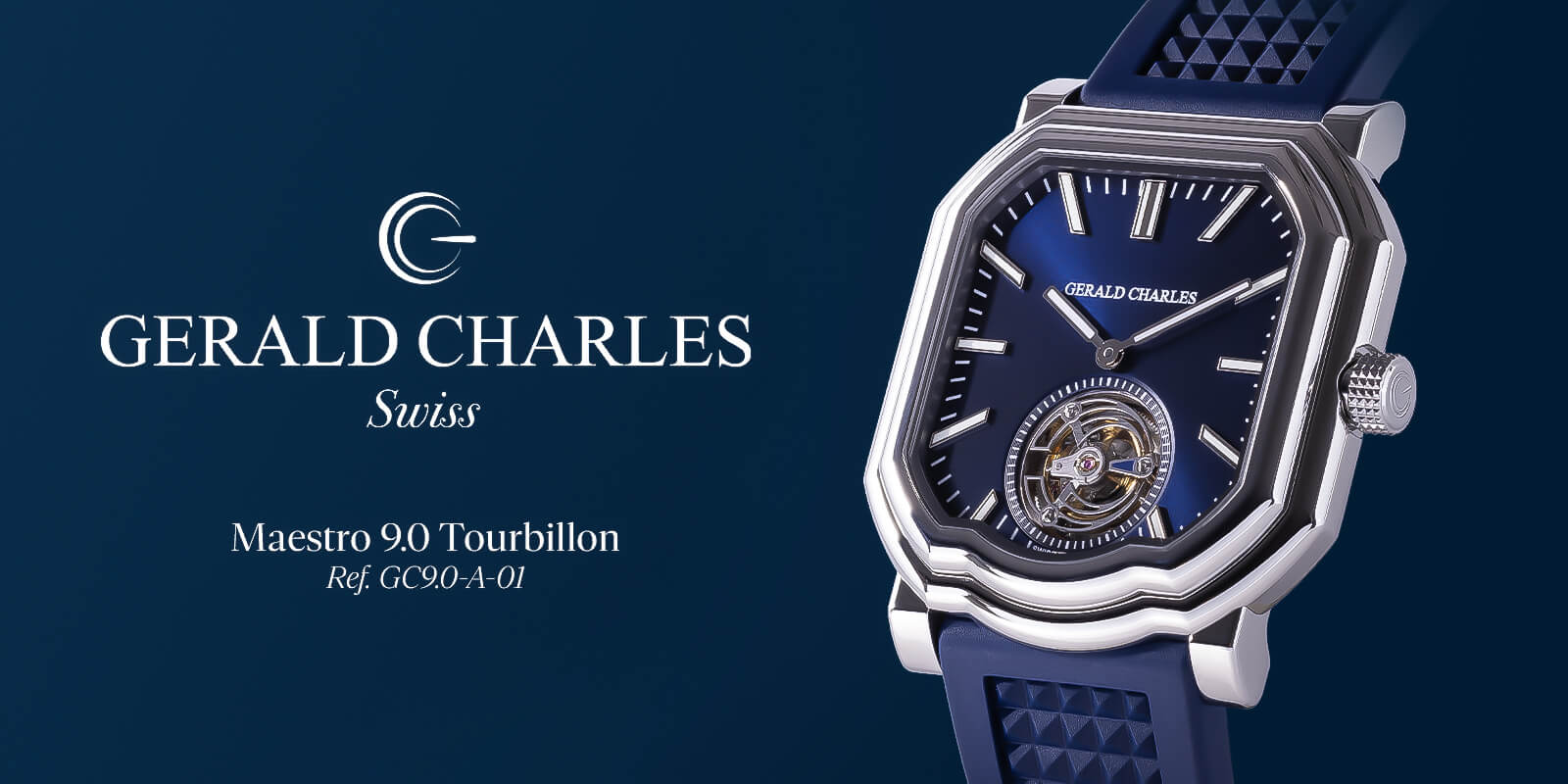
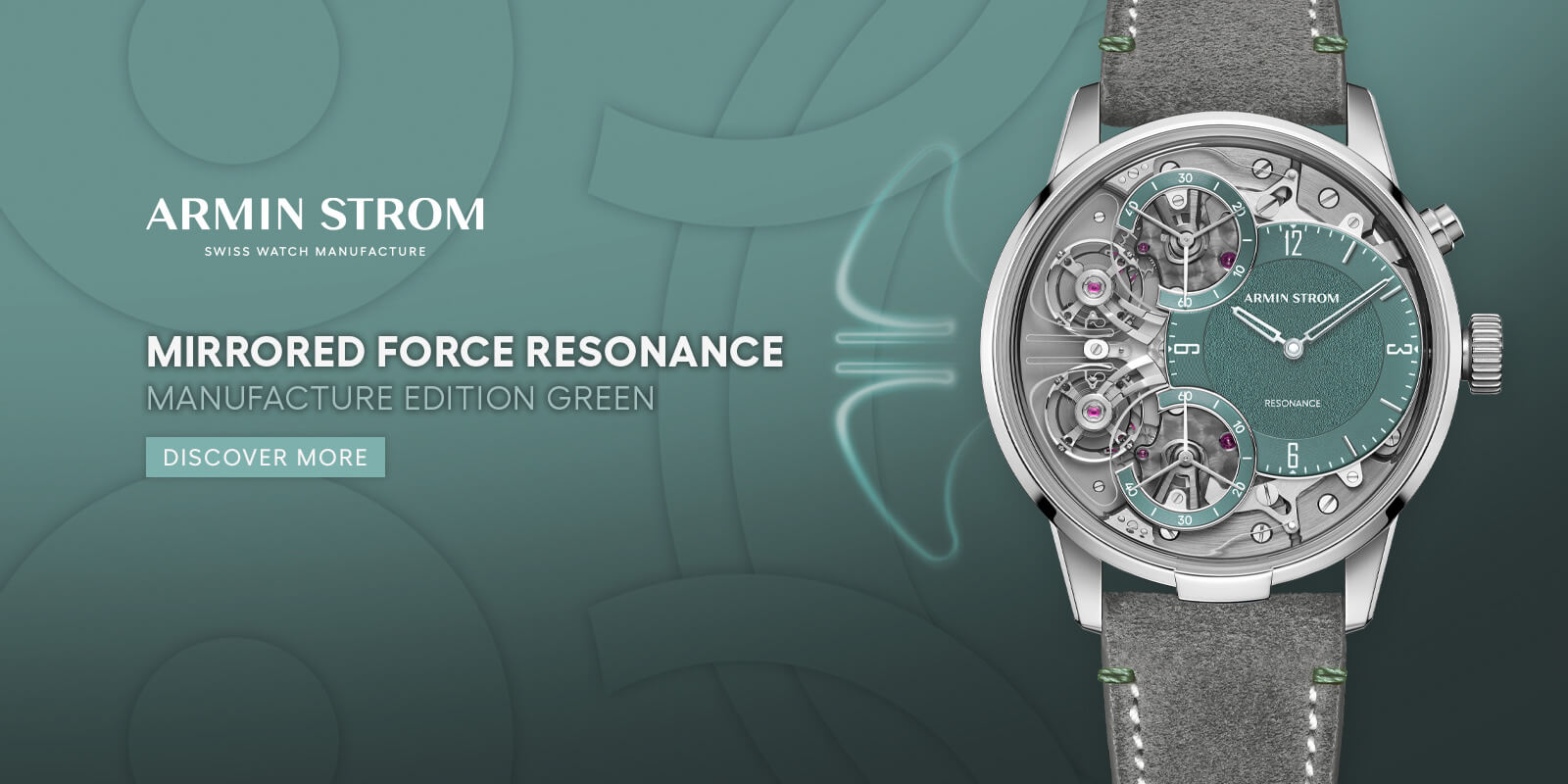
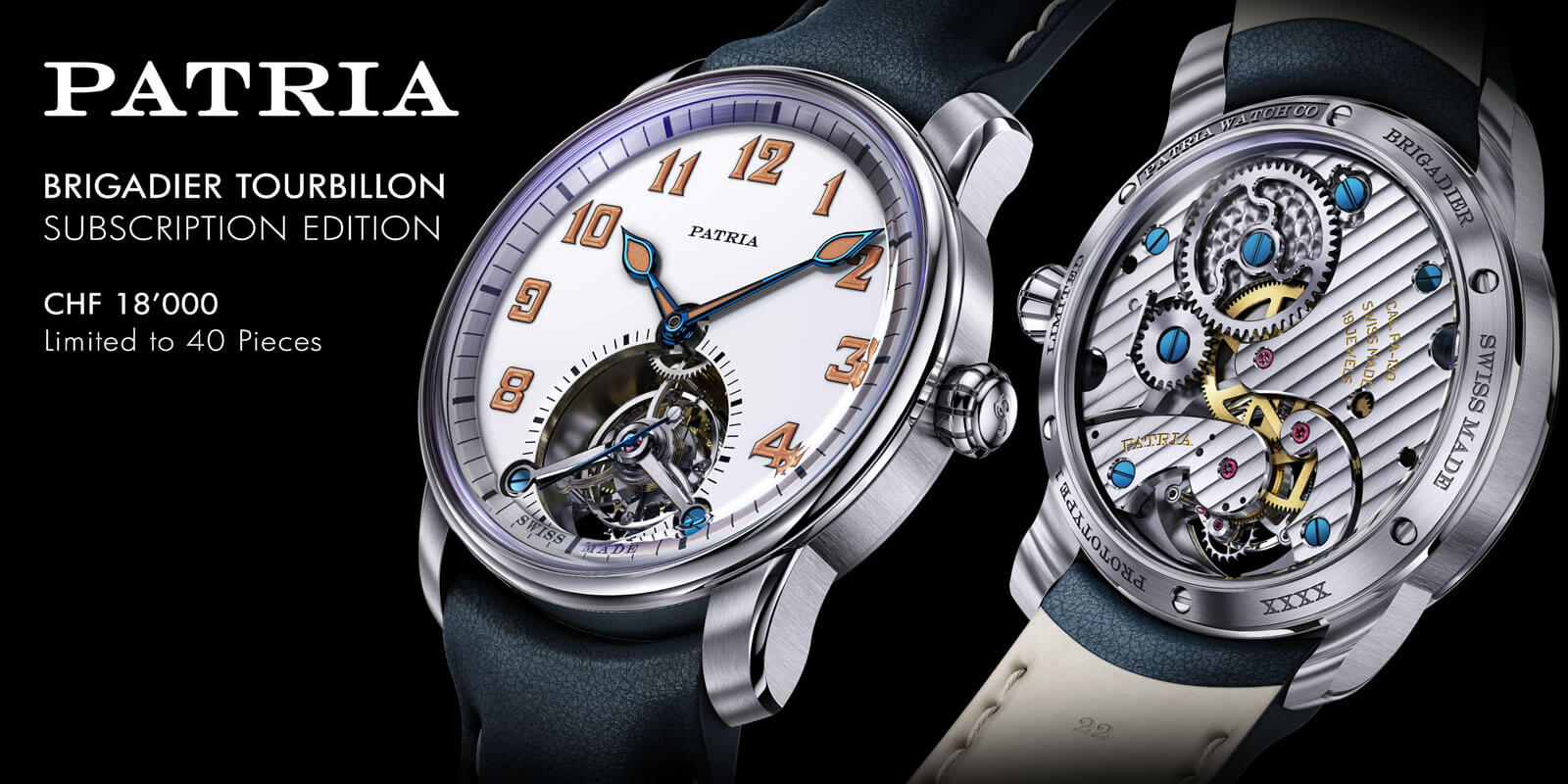


Sigh, Omega Constellations have the Geneva, not the Greenwich, Observatory on the case back.
Thanks for pointing that out, but you are only half right: it isn’t the Greenwich Observatory, but it isn’t the Geneva Observatory either, it is just a generic observatory.
From https://www.omegawatches.com/stories/the-observer
“An astronomical observatory emblem has featured on every single Constellation caseback since the collection was initially launched in 1952. The motif depicting the cupola of an observatory surrounded by eight stars was inspired by the observatory competitions. While popular legend pegs the cupola as belonging to the Geneva observatory, Omega Museum Director Petros Protopapas assures us it is more likely to be a generic depiction. The eight stars represent Omega’s greatest chronometric achievements at the annual observatory chronometer tests between 1945 and 1952.”
Regards, Ian
Ian,
Thank you for looking into it and an updating the article.
Best
Yachtie